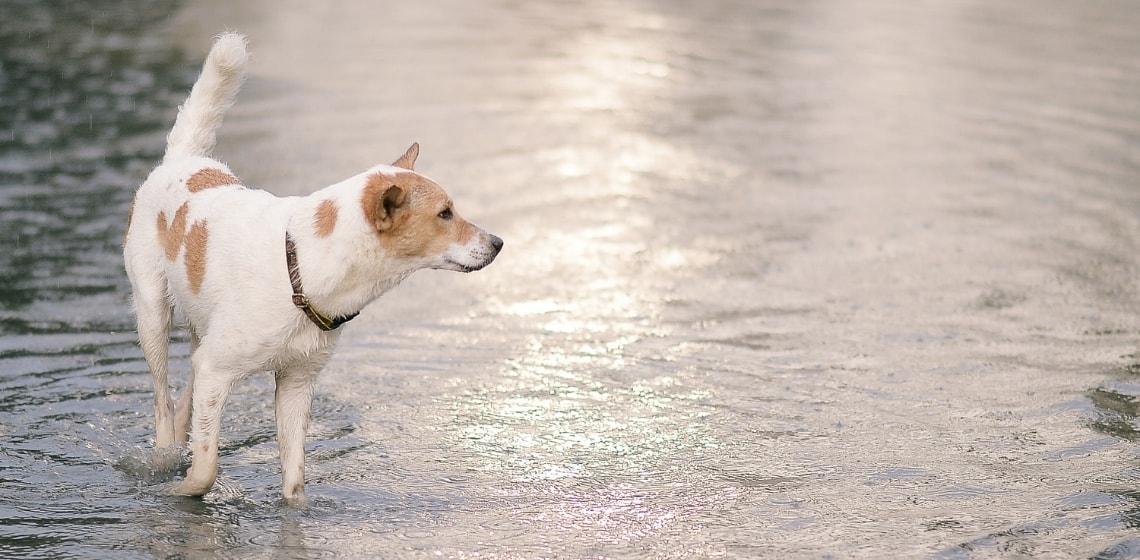Table of Contents
Stay Informed
As a storm carrying heavy rain approaches, it is essential that you monitor the storms predicted path. Frequently check weather predictions as this can quickly change. Pay close attention to alerts provided by EAS and frequently reference the National Oceanic and Atmospheric Administration website.
Have a Plan in Place
Knowing where to go and what to do ahead of actual flooding is essential. In areas of flooding, roadways are unsafe, even when water levels appear low. Establish somewhere you can go outside of the anticipated storm path that will be able to offer shelter to you and your animal companions. Give yourself plenty of time to evacuate, as roadways can quickly become unsafe amidst a storm. As little as 6 inches of water can cause a car to stall.
If evacuation is not in the cards, it is important to know the safest place to be within your home should flooding occur. You should seek higher ground like the upper floor of your house when possible if flooding is severe.
Gather Pet Necessities
When preparing for a natural hazard like flooding, special considerations will need to be made for pets. As always, it is critical to have a copy of important documents pertaining to your pet readily available. Examples of documents to have on hand include proof of rabies vaccination, recent blood work, microchip information and a list of medications your pet receives. These documents will be helpful to have if your pet requires veterinary care or needs to spend time in a shelter environment. Place all important documents in a waterproof bag to help prevent damage. Additionally, you must remember day-to-day necessities as well. These may include:
- Leash
- Harness/Collar
- Appropriate identification/contact tags
- Fresh Water
- Pet Carrier
- Food
- Medications
In the face of an impeding storm, try to stock up on at least 2 weeks’ worth of food and medications. Have the above items accessible in a waterproof bag or container that can be easily transported. This type of preparation is important for any type of natural disaster. Having an emergency bag ready to go is always recommended.
Gather Flood-Specific Items
Flooding offers a surplus of other important considerations when comparing it to other types of natural hazards. Below are additional items that will be helpful to have available should you be faced with flooding.
- Life jackets for all family members, including 4-legged companions
- Raft, kayak, canoe, boat (any sort of safe water transportation)
- Waterproof containers
- Waterproof jackets
- Towels
- Boots
Be Aware of Secondary Hazards
If possible, avoid entering flood waters. In some circumstances, this is impossible to do. If you must enter flood waters, you need to know the risk. During high rains, objects are pulled into water and can be difficult to see. These unrestrained objects can quickly travel in water and cause injury. Additionally, flood waters can have currents that can increase chances of injury and drowning.
Electrocution poses another risk as downed powerlines can occur. Drowning and potential hypothermia are of concern as well. OSHA provides information regarding hazards present in floods that should be evaluated by those at risk.
Animal Specific Flood Considerations
In the face of flooding, there are precautions that should be considered for your pet. Below are some considerations outlined by the American Kennel Club:
- Bring companion animals indoor when flooding is likely to occur
- Not all animals are able to swim, so do not assume your companion can do so
- Do not allow animals to drink from flood waters as they may have secondary contaminations
- Do not walk animals in flood conditions as they are at risk for injury from tree debris, trash, currents, etc
- Dry your pet off as much as possible to avoid hypothermia and secondary skin infections
Summary
Floods commonly occur throughout the United States. Flooding especially poses a threat to individuals in low lying areas or those living around bodies of water. Ensure necessities are gathered well in advance of an approaching storm and have an evacuation plan in place. Being prepared and knowing storm-related safety considerations will help keep you and your beloved companions safe.

Dr. Marti Dudley attended veterinary school at Ross University in St. Kitts, and completed her clinical year at Virginia-Maryland Regional College of Veterinary Medicine. Since graduating in 2014, Marti has worked as an associate veterinarian at a small animal practice in her hometown of Williamsburg, Virginia. She enjoys providing personalized care to patients and emphasizes the importance of preventative medicine. Marti shares her home with her husband and children, along with a menagerie of pets. In her spare time, she enjoys camping with her family and relaxing with her pets.








